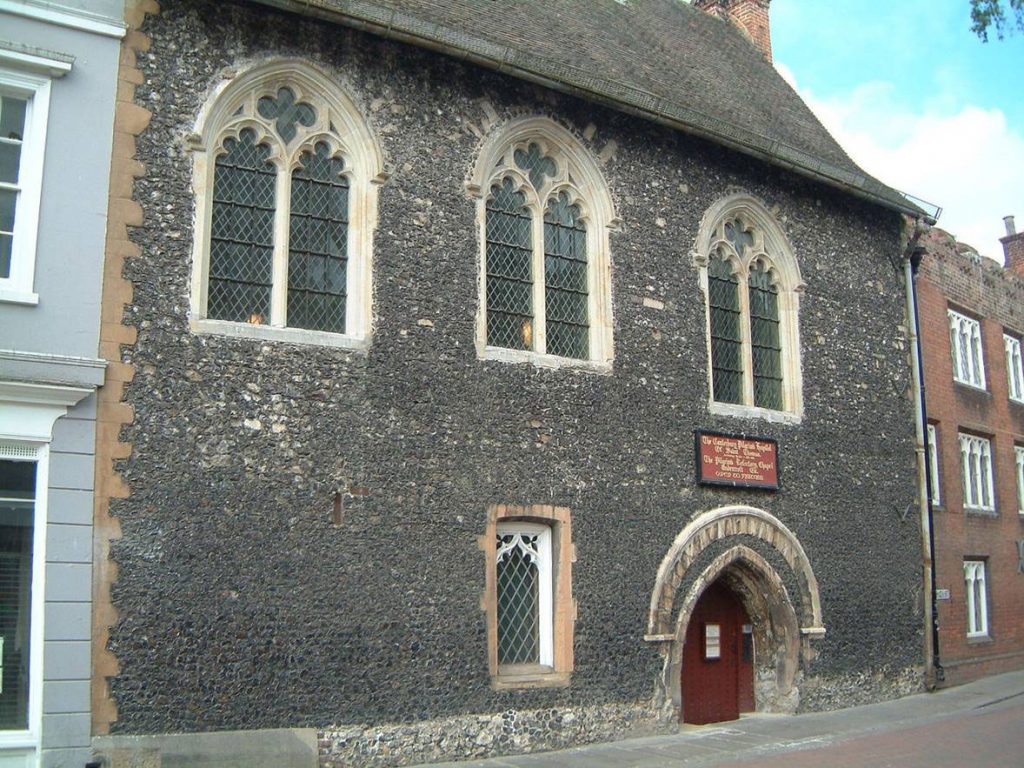Being somewhat new to Archive research it was with trepidation that I took my first few steps into this exciting field. My first duty was transcribing names from a couple of record books. One book was for Eastbridge Hospital – (1688) Admissions. It had a wealth of knowledge and interesting points detailed in it.
From the Glorious Revolution to the 1920s
Eastbridge Hospital was situated in the All Saints Parish of Canterbury, and was full of interesting facts and stories, dating from 1688 until the 1920s.
During my recent readings, I came upon references of the people who were allowed to reside within its walls. They were called ‘Out-brothers’ and ‘In sisters’. And had to obey the rules of the hospital, to the letter of the law. Otherwise, when I read on to a few instances, if disorderly conduct occurred, they were expelled.
I transcribed much of what follows from what William Somner wrote about the Hospitals at Northgate, Harlebaldown and Eastbridge in Canterbury.
Beginnings
Eastbridge Hospital was also called The Hospital of St Thomas The Martyr. William Somner is of the opinion that the hospital at Eastbridge was built around the time of Thomas Becket, and set up as a functional unit during and after the reign of King Henry II.
The hospitals were dedicated from St John the Baptist by William Somner, twinned with Harlebaldown. On the north side of the hospitals’ chapels was a burial ground for patients and members of the clergy.
The hospitals were divided for men, labouring under various occupations; the other part was for infirm women. They were provided with clothes and daily food. Servants also were used to care for the patients’ needs.
Hospital Rules
The hospitals’ maintenance for the poor, aged, and infirm, made no discrimination between both sexes. However, the men and women in the hospital were not allowed any communication between each other. It’s clear that some tried to bring family members or break the rules on gender mixing:
“Being given to undertake that the In-brothers and Out-Sisters of the two hospitals of Eastbridge and Harlebaldown, after their admission, on occasions, have neglected to admit that they are married, and sometimes, they bring a train of children with them. This situation can be a great inconvenience to the hospitals.
So therefore, and for the prevention of abuse, and corruption to come, the hospitals’ administrators decree that if any individuals fail to disclose their present standing, they shall be forced to quit, or will be expelled from the hospital.”
In addition, the yearly total for the upkeep of the hospitals during, around the time of 1652, was one hundred and fifty pounds. Payable under certain circumstances by whomever was Archbishop of Canterbury at the time. This was reinforced by an Act Of Parliament.
Myths and leprosy
From: The Modern and Ancient State of Eastbridge Hospital Canterbury
When Edward, the Black Prince, lay on his deathbed, he asked for water from the spring, behind Eastbridge hospital, as it was deemed to have healing qualities.
Thomas Newe of Wolton, was Master of Eastbridge Hospital from 1351 to 1379. He oversaw and made statements in 1371 that leprosy had nearly been eradicated.
Another remarkable fact connected with the hospital is that when Edward, the Black Prince, lay on his deathbed, he asked for water from the spring, behind Eastbridge hospital, as it was deemed to have healing qualities. This was due to the fact that leprosy cases in the hospital had become rare.
In the hospital at Eastbridge, there was a ledger book, containing an account of the whole fate of the paid hospital, in which were written at length, of all the grants, donations, lands, and benefactors, annually. The writings by William Somner, frequently mentions the treatment of the plague, accordingly performed at the hospital at Eastbridge in Canterbury. He says:
“In modern times, many people of high standing gave money to the hospital. In one case, Mrs. Elizabeth Lovejoy of Canterbury, by her will dated 1694, bequeathed to the hospitals an annual amount from her estate in Thanet. And many similar charitable bequeaths, from other respected citizens, helped in the upkeep of the hospitals in later times.”
Other names of interest that were connected to Eastbridge Hospital were William Juxon, who was Bishop of London at the time of Charles I execution in 1649.
Researching in the Canterbury Archives
The Canterbury Archives is a fascinating place to research in. When you enter the surroundings you are greeted with an air of pure local history and a wealth of precious documents. The looming shelved walls are filled with so many books. And microfilm records have people examining Parish Records with a keen eye. There are desktop computers situated in a few places where researchers can use the Ancestry site ‘Find My Past’ to give added, and deeper information to their work.
The large tables have researchers, studying documents, some ranging from the time of Henry II right up to the present day.










